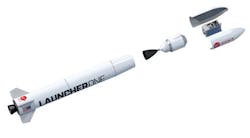Virgin Orbit tests rocket launch from Cosmic Girl 747-400 carrier aircraft mobile air launch pad
LONG BEACH, Calif. Virgin Orbit, an aerospace company that is part of the Virgin Group in Long Beach, California, is in the final stages of testing and preparing for the company’s LauncherOne two-stage, expandable LOX/RP-1 rocket to launch from its mobile air launch pad: a dedicated Boeing 747-400 shuttle carrier aircraft that goes by the name “Cosmic Girl”.
Cosmic Girl will carry LauncherOne to an altitude of approximately 35,000 feet before release for its rocket-powered flight to orbit. Starting each mission with an airplane rather than a traditional groundbased launch pad offers performance benefits in terms of payload capacity, but more importantly, air-launch offers an unparalleled level of flexibility, officials say.
LauncherOne will operate from a variety of locations independently of traditional launch ranges—which are often congested with traffic—and will have the ability to operate through or around weather conditions and other impediments that delay traditional launches.
Once released from the carrier aircraft, the LauncherOne rocket fires up its single main stage engine, a 73,500 lbf, LOX/RP-1 rocket engine called the “NewtonThree.” Typically, this engine will fire for approximately three minutes. After stage separation, the single upper stage engine, a 5,000 lbf LOX/RP-1 rocket engine called the “NewtonFour” will carry the satellite(s) into orbit. Typically, the second stage will execute multiple burns totaling nearly six minutes.
At the end of this sequence, LauncherOne will deploy our customers’ satellite (or satellites) into their desired orbit. Both stages of LauncherOne will be safely deorbited, while the carrier aircraft will return to a predetermined airport, where it can be quickly prepared for its next flight.
LauncherOne is capable of delivering 300 kilograms to a 500-kilometer Sun-Synchronous Orbit.
GomSpace in Denmark, with offices in Alexandria, Virginia, has signed on to launch its nanosatellites into orbit via Virgin Orbit’s LauncherOne in 2019. Read more here: http://www.intelligent-aerospace.com/articles/2018/01/gomspace-selects-virgin-orbit-launcherone-rocket-for-low-inclination-launch-of-nanosatellites.html
The go-to resource for Intelligent Aerospace technology news & information:
Covering key topics
Across all market segments
Subscribe to the free Intelligent Inbox e-newsletter: http://www.intelligent-aerospace.com/subscribe.html.
Connect on social media:
Keep pace with aerospace innovation and opportunities via your favorite social media channels. Connect with Intelligent Aerospace on Twitter (@IntelligentAero), LinkedIn,Google+, and Instagram.




